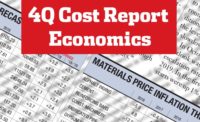The impact of lower oil prices on construction materials is more sketchy. Some will be hit, but other materials are not vulnerable to lower oil prices. And though some materials prices are falling, that has nothing to do with the drop in oil prices.
The obvious construction materials to reflect the massive drop in oil prices would be paving asphalt. Not so. "There is a major disconnect between falling oil prices and asphalt prices," says Charlie McCarren, construction materials economist with IHS Global Insight. There are several components in the manufacturing of asphalt that blunt the impact of lower oil prices, such as using lighter crude oil, which reduces the asphalt by-product, McCarrren says. "Asphalt may move in the same direction as oil, but it does not have the same volatility," he says.
IHS Global Insight forecasts the spot price for West Texas crude oil will fall 52% this year. But the same forecast calls for only a 4.1% decline in asphalt paving cost. IHS expects asphalt prices to decline another 1.2% in 2016 before rebounding 4.2% in 2017 and 3.7% in 2018.
However, there is a time lag to take into account, McCarren warns. "It takes about six months for lower crude-oil prices to trickle down through the supply chain. That is one reason we have not seen much of a reaction in the producer price indexes yet," he says.
"We have a big drop in input costs, but most material prices seem to be improving because there is no slowdown in demand," says McCarren. "Material [prices] are just not driven by input costs, such as energy, but also by demand in the marketplace. The one sector we expect to see a pullback is manufacturing, but general demand is improving, and that will put a floor beneath prices," he adds. As a consequence, lower input costs may result in larger profit margins for producers, rather than lower prices for contractors.
"We are not at a tipping point for most material prices yet. But by the end of the second quarter of this year, we think we may start seeing price declines for some materials," McCarren says.
The dramatic 52% decline in crude-oil prices is overshadowing the 25% decline in natural-gas prices that IHS Global Insight is forecasting. However, the drop in natural-gas prices may be more significant for construction materials, says McCarren. "Most construction materials producers have moved away from oil, in favor of natural gas," he says.
IHS Global Insight predicts that natural-gas prices will rebound 7.3% next year and another 10.5% in 2017. Likewise, it forecasts that the spot price for West Texas crude oil will bounce back 30.8% next year, followed by another 16.8% gain in 2017. The prediction for the average U.S. gasoline price is more subdued: After an expected 41.7% decline this year, prices are predicted to rebound 9.9% in 2016 and another 5.0% in 2017.
IHS also recently released its latest Procurement Executive Group survey index. That PEG index dropped to 42.4%. It is a diffusion index, which means when it drops below 50, more firms are reporting price declines than increases. However, it does not measure the magnitude of the declines, only the direction, says McCarren. In addition, the index was only created in 2011, so claims of a record low should be taken with a grain of salt, he says.
Prices for other construction materials also are falling, but the declines have little to do with lower oil prices. The Bureau of Labor Statistics' producer price index for softwood lumber in February was down 4.5% from a year ago, which is mostly due to the soft rebound in housing.





Post a comment to this article
Report Abusive Comment